Thorsten Wild
Target Detection for ISAC with TDD Transmission
Apr 27, 2025Abstract:Integrated sensing and communication (ISAC) poses various challenges that arise from the communication-centric design of cellular networks. One of them is target detection with time division duplex (TDD) transmission used in current 5G and future 6G deployments, where the periodic on-off behavior of the transmitter creates impulsive sidelobes in the radar point spread function (PSF). These can be mistaken for actual targets by conventional peak detection techniques, leading to false alarms. In this work, we first analytically describe the range-Doppler PSF due to TDD windowing. We then propose a computationally efficient method that leverages the PSF to distinguish impulsive sidelobes from valid target peaks. Simulation results and outdoor drone measurements with an ISAC proof of concept demonstrate the capability of our algorithm, showing that it can achieve reliable target detection while limiting false alarms.
Bistatic Information Fusion for Positioning and Tracking in Integrated Sensing and Communication
Oct 15, 2024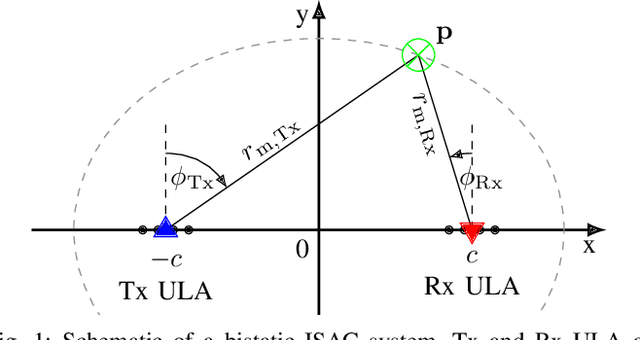
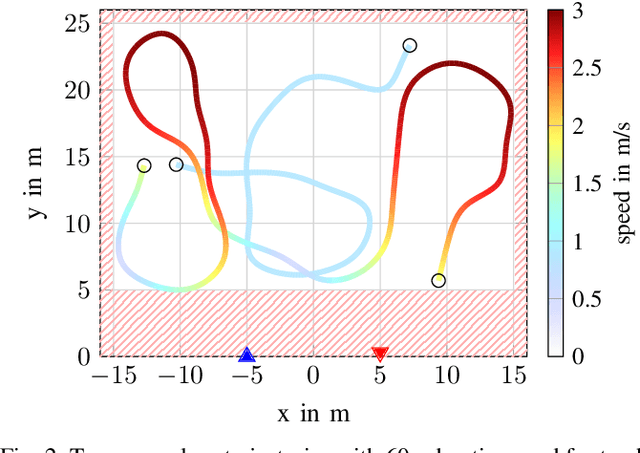
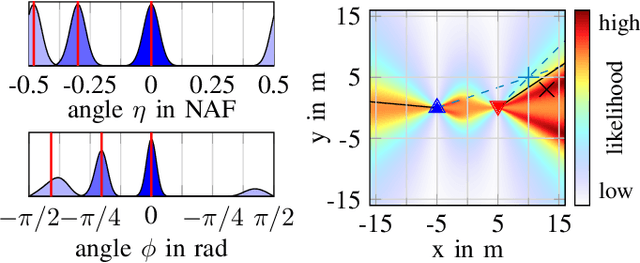
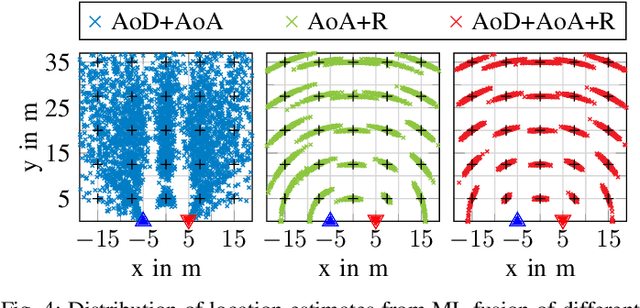
Abstract:The distributed nature of cellular networks is one of the main enablers for integrated sensing and communication (ISAC). For target positioning and tracking, making use of bistatic measurements is non-trivial due to their non-linear relationship with Cartesian coordinates. Most of the literature proposes geometric-based methods to determine the target's location by solving a well-defined set of equations stemming from the available measurements. The error covariance to be used for Bayesian tracking is then derived from local Taylor expansions. In our work we adaptively fuse any subset of bistatic measurements using a maximum likelihood (ML) framework, allowing to incorporate every possible combination of available measurements, i.e., transmitter angle, receiver angle and bistatic range. Moreover, our ML approach is intrinsically flexible, as it can be extended to fuse an arbitrary number of measurements by multistatic setups. Finally, we propose both a fixed and dynamic way to compute the covariance matrix for the position error to be fed to Bayesian tracking techniques, like a Kalman filter. Numerical evaluations with realistic cellular communications parameters at mmWave frequencies show that our proposal outperforms the considered baselines, achieving a location and velocity root mean square error of 0.25 m and 0.83 m/s, respectively.
Constellation Shaping under Phase Noise Impairment for Sub-THz Communications
Nov 21, 2023Abstract:The large untapped spectrum in the sub-THz allows for ultra-high throughput communication to realize many seemingly impossible applications in 6G. One of the challenges in radio communications in sub-THz is the hardware impairments. Specifically, phase noise is one key hardware impairment, which is accentuated as we increase the frequency and bandwidth. Furthermore, the modest output power of the sub-THz power amplifier demands limits on peak to average power ratio (PAPR) signal design. Single carrier frequency domain equalization (SC-FDE) waveform has been identified as a suitable candidate for sub-THz, although some challenges such as phase noise and PAPR still remain to be tackled. In this work, we design a phase noise robust, low PAPR SC-FDE waveform by geometrically shaping the constellation under practical conditions. We formulate the waveform optimization problem in its augmented Lagrangian form and use a back-propagation-inspired technique to obtain a constellation design that is numerically robust to phase noise, while maintaining a low PAPR.
Multi-Target Localization in Multi-Static Integrated Sensing and Communication Deployments
Jun 13, 2023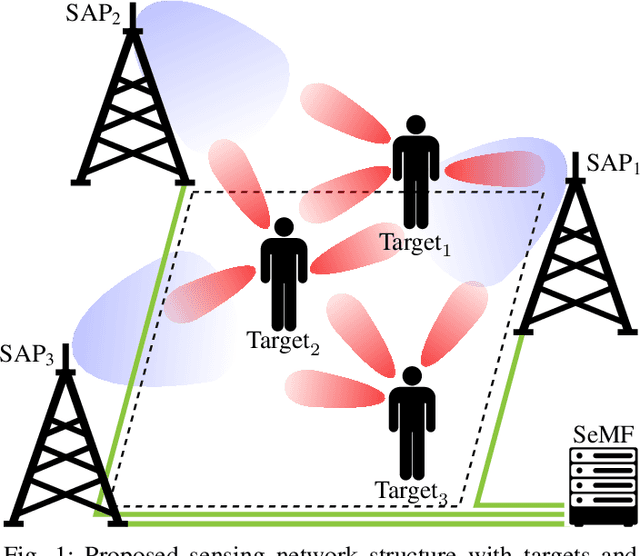
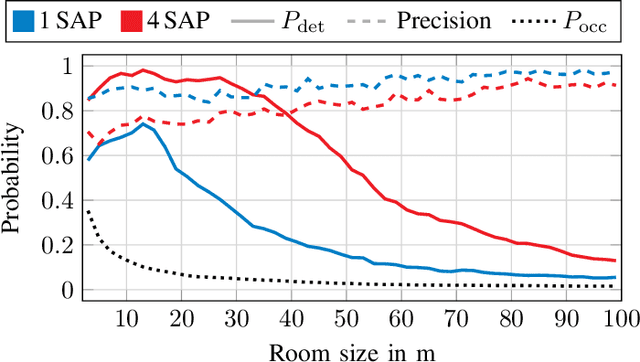


Abstract:In future wireless communication networks, existing active localization will gradually evolve into more sophisticated (passive) sensing functionalities. One main enabler for this process is the merging of information collected from the network's nodes, sensing the environment in a multi-static deployment. The current literature considers single sensing node systems and/or single target scenarios, mainly focusing on specific issues pertaining to hardware impairments or algorithmic challenges. In contrast, in this work we propose an ensemble of techniques for processing the information gathered from multiple sensing nodes, jointly observing an environment with multiple targets. A scattering model is used within a flexibly configurable framework to highlight the challenges and issues with algorithms used in this distributed sensing task. We validate our approach by supporting it with detailed link budget evaluations, considering practical millimeter-wave systems' capabilities. Our numerical evaluations are performed in an indoor scenario, sweeping a variety of parameter to analyze the KPIs sensitivity with respect to each of them. The proposed algorithms to fuse information by multiple nodes show significant gains in terms of targets' localization performance, with up to 35\% for the probability of detection, compared to the baseline with a mono-static setup.
Minimizing Energy Consumption in MU-MIMO via Antenna Muting by Neural Networks with Asymmetric Loss
Jun 08, 2023Abstract:Transmit antenna muting (TAM) in multiple-user multiple-input multiple-output (MU-MIMO) networks allows reducing the power consumption of the base station (BS) by properly utilizing only a subset of antennas in the BS. In this paper, we consider the downlink transmission of an MU-MIMO network where TAM is formulated to minimize the number of active antennas in the BS while guaranteeing the per-user throughput requirements. To address the computational complexity of the combinatorial optimization problem, we propose an algorithm called neural antenna muting (NAM) with an asymmetric custom loss function. NAM is a classification neural network trained in a supervised manner. The classification error in this scheme leads to either sub-optimal energy consumption or lower quality of service (QoS) for the communication link. We control the classification error probability distribution by designing an asymmetric loss function such that the erroneous classification outputs are more likely to result in fulfilling the QoS requirements. Furthermore, we present three heuristic algorithms and compare them with the NAM. Using a 3GPP compliant system-level simulator, we show that NAM achieves $\sim73\%$ energy saving compared to the full antenna configuration in the BS with $\sim95\%$ reliability in achieving the user throughput requirements while being around $1000\times$ and $24\times$ less computationally intensive than the greedy heuristic algorithm and the fixed column antenna muting algorithm, respectively.
CRAP: Clutter Removal with Acquisitions Under Phase Noise
Jun 01, 2023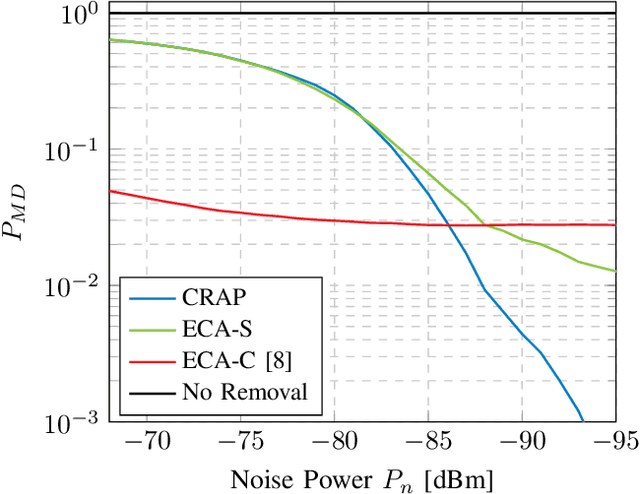
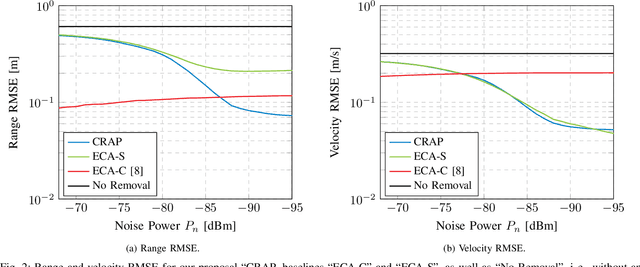
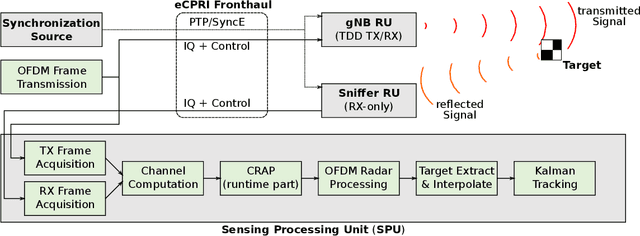
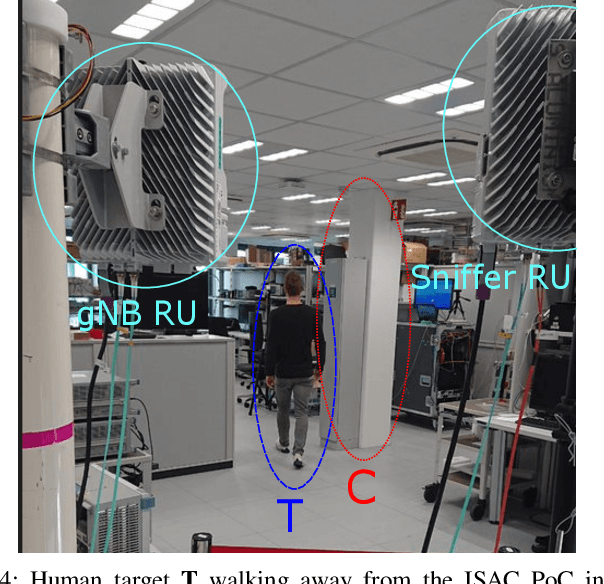
Abstract:The emergence of Integrated Sensing and Communication (ISAC) in future 6G networks comes with a variety of challenges to be solved. One of those is clutter removal, which should be applied to remove the influence of unwanted components, scattered by the environment, in the acquired sensing signal. While legacy radar systems already implement different clutter removal algorithms, ISAC requires techniques that are tailored to the envisioned use cases and the specific challenges that communications deployments bring along, like phase noise due to clock errors between transmitter and receiver. To that end, in this work we introduce Clutter Removal with Acquisitions Under Phase Noise (CRAP). We propose to vectorize the time-frequency channel acquired in a radio frame in a high-dimensional space. In an offline clutter acquisition step, singular value decomposition is used to determine the major clutter components. At runtime, the clutter is then estimated and removed by a subspace projection of the acquired radio frame onto the clutter components. Simulation results prove that CRAP offers benefits over prior art techniques robust to phase noise. In particular, our proposal does not suppress zero Doppler information, thereby enabling the detection of slow targets. Moreover, we show CRAP's real-time applicability in a millimeter-wave ISAC proof of concept, where a pedestrian is tracked in a cluttered lab environment.
Survey on Integrated Sensing and Communication Performance Modeling and Use Cases Feasibility
May 15, 2023Abstract:As the research community starts to address the* key features of 6G cellular standards, one of the agreed bridge topics to be studied already in 5G advanced releases is Integrated Sensing and Communication (ISAC). The first efforts of the research community are focusing on ISAC enablers, fundamental limits, and first demonstrators, that show that the time has come for the deployment of sensing functionalities in cellular standards. This survey paper takes a needed step towards ISAC deployment, providing an analytical toolkit to model cellular systems' sensing performance, accounting for both their fundamental and practical constraints. We then elaborate on the likely features of 6G systems to provide the feasible sensing key performance indicators (KPIs) in the frequency ranges spanned by cellular networks, including the potential new bands available in 6G, the Frequency Range 3 (FR3). We further validate our framework by visually investigating ISAC constraints with simulation examples. Finally, we assess the feasibility of few selected scenarios that can be enabled by ISAC, highlighting in each of them the limiting factor and, thus, which gaps should be filled by the research and standardization communities in the next years.
6G Integrated Sensing and Communication: From Vision to Realization
May 03, 2023Abstract:Integrated sensing and communications (ISAC) will be deployed into cellular communication systems possibly already with 5G-A and surely in 6G. This paper discusses ISAC use cases, key technology building blocks for system design with solutions and open research questions. Furthermore, we introduce our proof-of-concept (PoC) based on commercially available 5G communications hardware at mm-Wave frequencies, with sensing-specific algorithmic extensions. This new ISAC PoC can perform jointly high data-rate communications and OFDM radar sensing in the same frequency band. Initial pedestrian detection results are shown, indicating the practicability of ISAC in future cellular networks. The results also indicate our achievable sensing range and provide hints to the achievable range estimation accuracy, based on the stability of the PoC system communications hardware.
Jamming Resilient Indoor Factory Deployments: Design and Performance Evaluation
Feb 02, 2022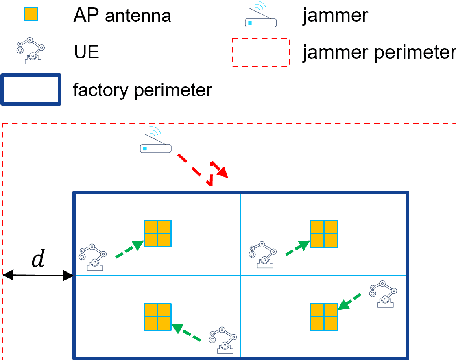
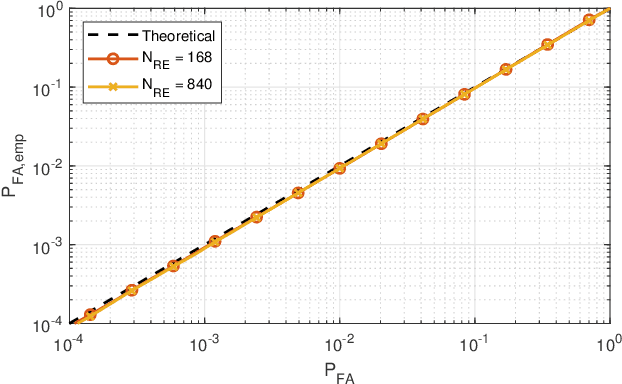
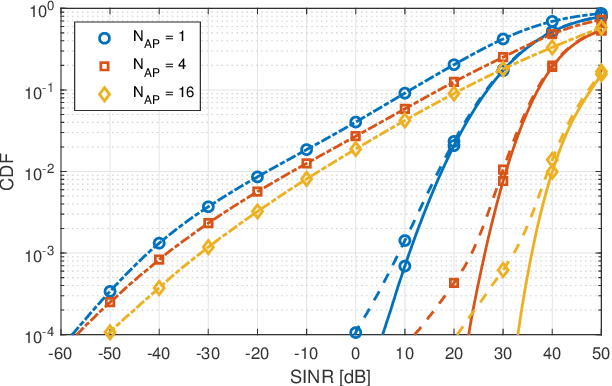
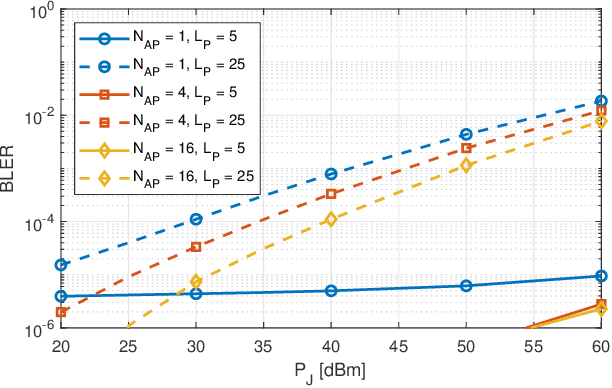
Abstract:In the framework of 5G-and-beyond Industry 4.0, jamming attacks for denial of service are a rising threat which can severely compromise the system performance. Therefore, in this paper we deal with the problem of jamming detection and mitigation in indoor factory deployments. We design two jamming detectors based on pseudo-random blanking of subcarriers with orthogonal frequency division multiplexing and consider jamming mitigation with frequency hopping and random scheduling of the user equipments. We then evaluate the performance of the system in terms of achievable BLER with ultra-reliable low-latency communications traffic and jamming missed detection probability. Simulations are performed considering a 3rd Generation Partnership Project spatial channel model for the factory floor with a jammer stationed outside the plant trying to disrupt the communication inside the factory. Numerical results show that jamming resiliency increases when using a distributed access point deployment and exploiting channel correlation among antennas for jamming detection, while frequency hopping is helpful in jamming mitigation only for strict BLER requirements.
Explicit CSI Feedback Compression via Learned Approximate Message Passing
Oct 12, 2021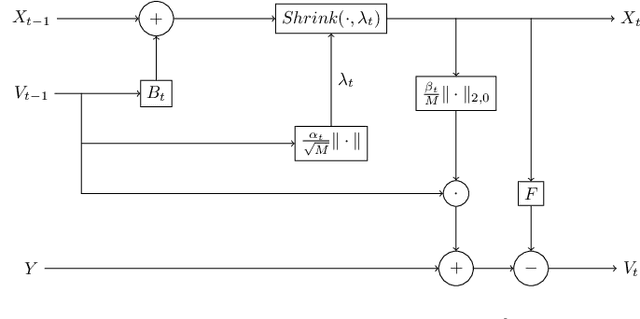
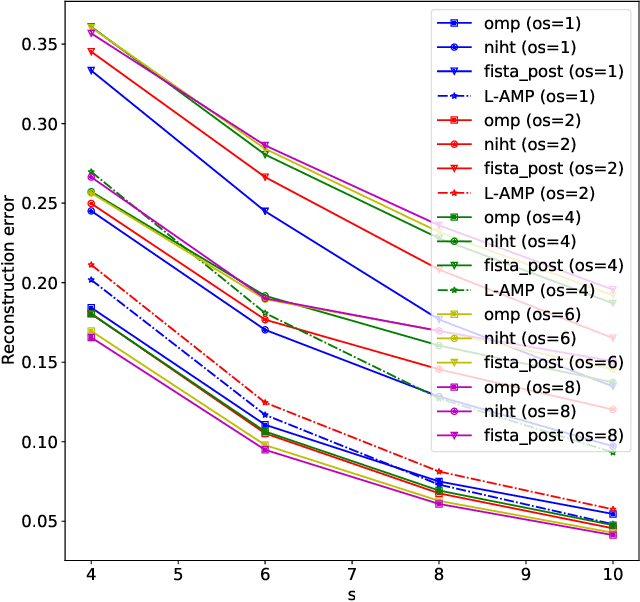
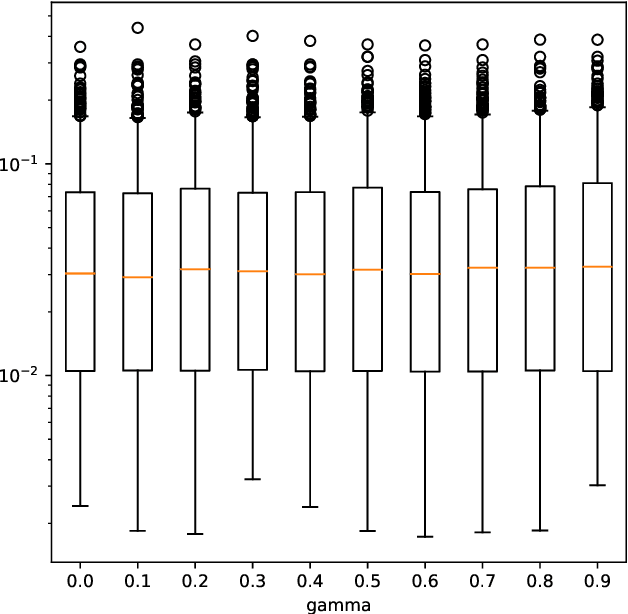
Abstract:Explicit channel state information at the transmitter side is helpful to improve downlink precoding performance for multi-user MIMO systems. In order to reduce feedback signalling overhead, compression of Channel State Information (CSI) is essential. In this work different low complexity compressed sensing algorithms are compared in the context of an explicit CSI feedback scheme for 5G new radio. A neural network approach, based on learned approximate message passing for the computation of row-sparse solutions to matrix-valued compressed sensing problems is introduced. Due to extensive weight sharing, it shares the low memory footprint and fast evaluation of the forward pass with few iterations of a first order iterative algorithm. Furthermore it can be trained on purely synthetic data prior to deployment. Its performance in the explicit CSI feedback application is evaluated, and its key benefits in terms of computational complexity savings are discussed.
 Add to Chrome
Add to Chrome Add to Firefox
Add to Firefox Add to Edge
Add to Edge